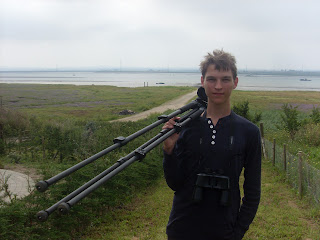PITSTONE VILLAGE
My first early start for days. After a long bike ride to Pitstone Village, I eventually arrived at the wood where the two Turtle Doves were last reported a few weeks ago. The song of a single purring ♂ TURTLE DOVE soon became audible over the cooing of the Woodpigeons but despite waiting for some time it never decided to make an appearance. To my frustration, it was clearly singing only a few metres to the left of one of the gaps through which I could view in the hedge but it refused to move. Furthermore it was on private property so getting a better view would not have been possible.
the gap in the hedge, not a very high likelihood that it will miraculously appear in it
IVINGHOE HILLS
Next stop was Ivinghoe Beacon were I hoped to catch up with a few chalk-land butterflies as the morning progressed. I ended up spending longer at the hills than I had anticipated but it was definitely worth it as I managed to locate 5 DARK-GREEN FRITILLARIES (a life tick). It took some time for me to eventually find a male that showed very well as it was sunning itself on a bare patch of open ground. However, after getting lucky once they seemed to materialise everywhere. Dozens of Chalk-hill Blues were also on the wing, an equally stunning butterfly, including 3 brown females. Other butterflies of note, included 1 Small Heath, 1 Small Copper, Small Skippers and dozens of Gatekeepers, Marbled Whites and Meadow Browns. Also about were 6-spotted Burnets and a single Pyramidal Orchid.
Ivinghoe Beacon
Marbled White with what appears to be a red parasite on the back of its abdomen, could anyone confirm this for me?
male Chalk-hill Blue
female Chalk-hill Blue
Ivinghoe Hills
what appears like a leucistic Meadow Brown, must some research into the topic of abnormally pale butterflies
Red Bartsia
female Common Blue Damselfly
Dark-green Fritillary sunning
COLLEGE LAKE
College Lake was next on the menu. The butterflies once again stole the centre stage, despite my intention to search for early migrant waders. The highlights being 2 mating Green-veined Whites, 1 Small Copper, 4 Marbled Whites, 1 Common Blue, Meadow Browns and lots of Gatekeepers. A few birds were also about, mostly residing on the marsh. 3 Common Sandpipers, 1 Little Ringed Plover, 1 Red Kite and a hunting Hobby were the highlights.
Small Copper
female Common Blue Damselfly
TRING PARK
With the intention to look for raptors, I sat myself down on the slopes overlooking a band of wooded area at Tring Park (a new site for me). Unsurprisingly, no rare raptors, however, after some time overlooking the landscape, I noticed something flit up from the vegetation and land in the bush next to me. It gave its ID away almost instantly as it vibrated its tail, you guessed it, it was a 1st-year ♂ REDSTART! I followed it around for some time as it gave tantalisingly brief views out in the open before moving to a different hedge and then going into dense cover as evening approached. On one occasion it returned to its perch after catching a Meadow Brown from the grass and it promptly devoured it.
picturesque chalk downland
1st-year male Redstart
Six-spot Burnet
Other birds of note during my visit included 3 Red Kites a Sparrowhawk circling over a potential nest site with prey in its talons and a displaying Stock Dove. A few butterflies were still on the wing by late afternoon, including 1 Small Heath and the usual Marbled Whites and Meadow Browns. A local dog-walker also pointed out a Common Spotted Orchid to me, one of the last for the season.









































